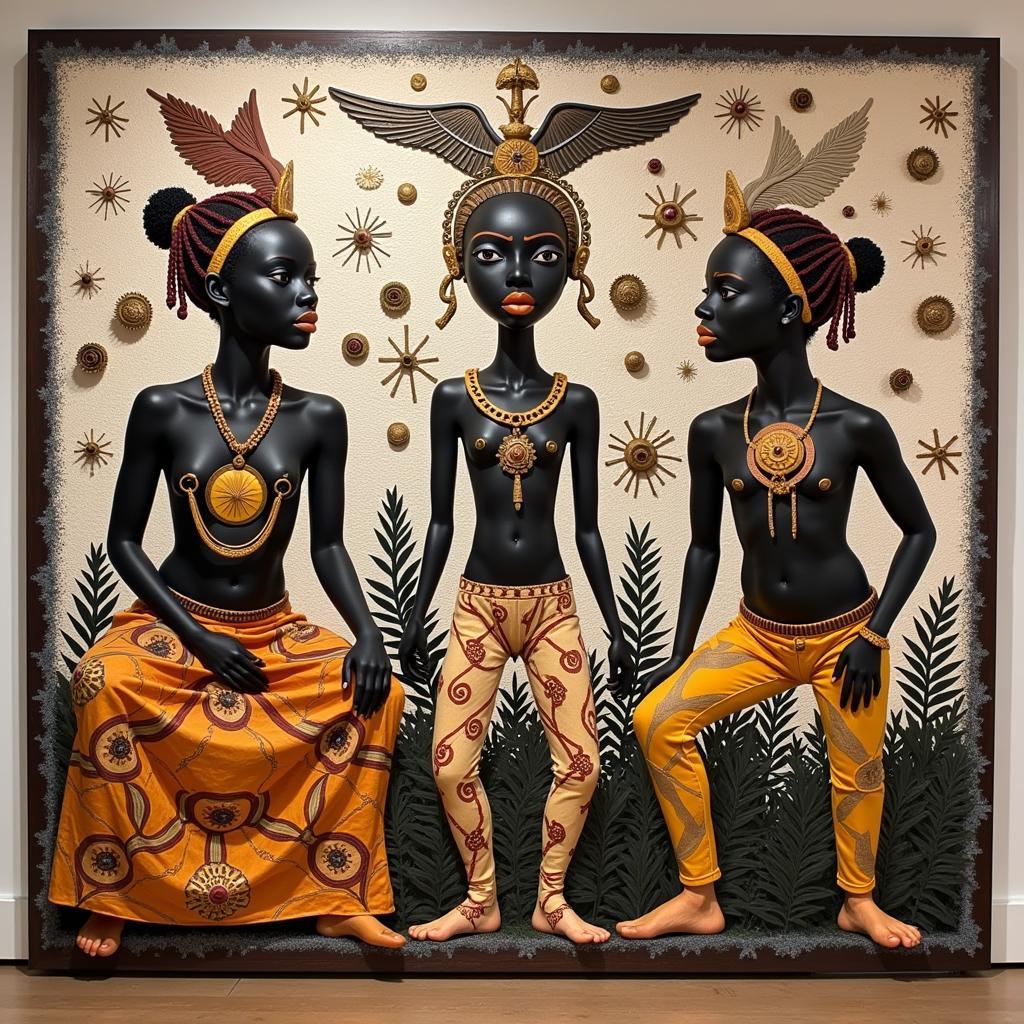Art Representation Of Ase In Yoruba culture delves into the fascinating intersection of Yoruba spirituality and artistic expression. ASE, a fundamental concept in Yoruba cosmology, represents the power to make things happen, the vital force that animates the universe. This article explores how this potent force is visually manifested in Yoruba art forms, from sculptures and masks to textiles and even architecture.
The concept of ASE permeates Yoruba cosmology and is central to their understanding of the universe and their place within it. It is not simply power, but a dynamic, creative force that manifests in all things, both tangible and intangible. Artists have sought to capture the essence of ASE through various mediums, providing a window into the rich spiritual world of the Yoruba people. ASE isn’t just a philosophical concept; it’s a lived reality deeply embedded in everyday life and reflected in their artistic creations. We will examine the specific artistic elements and symbolism used to depict ASE and their significance in Yoruba culture.
The Visual Language of ASE: Symbols and Motifs
Yoruba art employs a complex visual language to represent ASE. Specific symbols and motifs recur, each carrying layers of meaning that convey the dynamic and transformative nature of this vital force. For instance, the color white is often associated with ASE, symbolizing purity, clarity, and spiritual elevation. Certain animals, such as the chameleon and the tortoise, are also linked to ASE, representing adaptability, resilience, and the power to effect change. These symbols, when integrated into art, evoke a sense of the profound and mysterious force that ASE embodies.
The double-headed axe, or oshe Shango, a symbol of the Yoruba deity of thunder and lightning, is another powerful representation of ASE. It embodies the dynamic and transformative power of ASE, its capacity to both create and destroy. The swirling patterns often found in Yoruba textiles can also symbolize the ever-flowing, ever-changing nature of ASE. These visual representations provide a tangible link to the abstract concept of ASE, making it more accessible and understandable.
ASE in Yoruba Sculpture and Masks
Yoruba sculptures and masks, particularly those representing deities or ancestors, are often imbued with ASE. The sculptures are not mere representations but are believed to be vessels for the very force they depict. The artists infuse ASE into their creations through rituals and prayers, transforming them into active participants in the spiritual realm. These sculptures and masks become conduits for ASE, allowing individuals to connect with the spiritual world and experience the transformative power of this vital force.
The pose, gesture, and facial expression of a sculpture can all convey different aspects of ASE. A figure standing tall with arms outstretched might represent the expansive and generative nature of ASE, while a figure in a meditative pose might symbolize the inner power and focus associated with this force. These subtle nuances in representation allow for a complex and layered understanding of ASE.
ASE in Everyday Life: Textiles and Architecture
The representation of ASE extends beyond religious art and finds its way into everyday objects like textiles and even architecture. Elaborate patterns woven into cloth, often used in ceremonies and rituals, can symbolize the intricate and interconnected nature of ASE. The layout of a traditional Yoruba compound, with its central courtyard and surrounding buildings, can reflect the principles of balance and harmony central to the understanding of ASE. This integration of ASE into the fabric of daily life reinforces its significance in Yoruba culture.
 Yoruba Textiles with ASE Patterns
Yoruba Textiles with ASE Patterns
“ASE is not merely a concept; it is the very breath of life in Yoruba culture,” explains Dr. Adeola Olaniyan, a renowned scholar of Yoruba art and spirituality. “It is the animating force that connects the physical and spiritual realms, and Yoruba artists masterfully capture this connection through their diverse forms of artistic expression.”
The Continuing Evolution of ASE Representation
While traditional representations of ASE remain powerful, contemporary Yoruba artists continue to explore new ways of expressing this fundamental concept. They draw inspiration from traditional forms while incorporating modern techniques and materials, ensuring the continued relevance of ASE in a changing world. This ongoing evolution demonstrates the enduring power and adaptability of ASE within Yoruba culture.
“The interpretation of ASE is not static,” adds Chief Babatunde Adebayo, a respected Yoruba elder and community leader. “It is a living force that continues to evolve and inspire new forms of artistic expression, reflecting the dynamic nature of Yoruba culture itself.”
 Contemporary Yoruba Art Depicting ASE
Contemporary Yoruba Art Depicting ASE
Conclusion
Art representation of ASE in Yoruba culture offers a unique lens through which to understand the complex spiritual beliefs of the Yoruba people. From sculptures and masks to textiles and architecture, ASE is woven into the very fabric of their existence. By exploring the intricate symbolism and artistic techniques employed to depict ASE, we gain a deeper appreciation for its central role in shaping Yoruba identity and worldview. The continuing evolution of ASE representation in art ensures its continued relevance for generations to come. Understanding the art of ASE is crucial to understanding Yoruba culture itself.
FAQ
-
What is ASE in Yoruba culture?
ASE is the life force, the power to make things happen. -
How is ASE represented in Yoruba art?
Through symbols like the double-headed axe, colors, animals, and specific poses in sculptures. -
Why is ASE important in Yoruba art?
It represents a core belief and allows connection to the spiritual world. -
What are some examples of Yoruba art that depict ASE?
Sculptures, masks, textiles, and even architecture. -
Are there modern interpretations of ASE in art?
Yes, contemporary artists continue to explore new ways to express ASE. -
Where can I learn more about Yoruba art and ASE?
Museums, cultural centers, and academic resources specializing in Yoruba culture. -
What is the significance of the double-headed axe in representing ASE?
It symbolizes the dynamic and transformative power of ASE, its ability to create and destroy.
For further exploration, consider researching Yoruba deities associated with ASE, such as Shango and Obatala, or delving into the symbolism of specific animals and colors in Yoruba art. You can also find more information about Yoruba culture and traditions through online resources and academic publications.
If you need further assistance, please contact us. Phone: 0369020373, Email: [email protected]. Our address is: Thon Ngoc Lien, Hiep Hoa, Bac Giang, Vietnam. We have a 24/7 customer service team.

